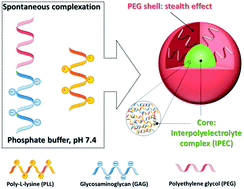Tunable nano-carriers from clicked glycosaminoglycan block copolymers†
Abstract
Oxime click reaction is used for the synthesis of diblock copolymers of polyethylene glycol (PEG) and glycosaminoglycans (GAGs) with different molecular weights (Mw) and sulfation degrees. The ability of these copolymers to carry positively charged proteins is evidenced by their assembly with poly-L-lysine as a model: interpolyelectrolyte complexes with tunable size at the nanometric scale (radius of 25–90 nm) and narrow distribution are described. We demonstrate that there is a critical Mw of GAGs for the formation of stable complexes and that the sulfation degree determines the size of the nano-assemblies. Highly sulfated GAGs form the smallest complexes that are stable to at least 500 mM ionic strength: a property that is not usual for GAG interpolyelectrolyte complexes. The feasibility of the synthesised block copolymers as protein carriers is further evidenced by their complexation with fibroblast growth factor (FGF-2). The described assets of GAG block copolymers together with the intrinsic GAG properties such as biorecognition and biodegradability open up new opportunities in the design of selective encapsulation/release nanosystems with a stealth PEG corona.


 Please wait while we load your content...
Please wait while we load your content...